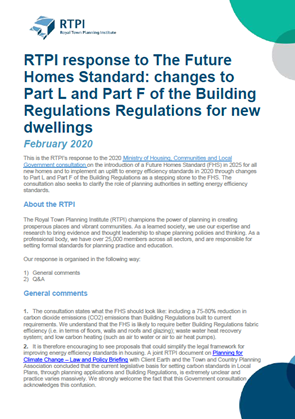RTPI response to The Future Homes Standard: changes to Part L and Part F of the Building Regulations Regulations for new dwellings
February 2020
 This is the RTPI’s response to the 2020 Ministry of Housing, Communities and Local Government consultation on the introduction of a Future Homes Standard (FHS) in 2025 for all new homes and to implement an uplift to energy efficiency standards in 2020 through changes to Part L and Part F of the Building Regulations as a stepping stone to the FHS. The consultation also seeks to clarify the role of planning authorities in setting energy efficiency standards.
This is the RTPI’s response to the 2020 Ministry of Housing, Communities and Local Government consultation on the introduction of a Future Homes Standard (FHS) in 2025 for all new homes and to implement an uplift to energy efficiency standards in 2020 through changes to Part L and Part F of the Building Regulations as a stepping stone to the FHS. The consultation also seeks to clarify the role of planning authorities in setting energy efficiency standards.
Read the RTPI's full response below or download it in PDF here.
About the RTPI
The Royal Town Planning Institute (RTPI) champions the power of planning in creating prosperous places and vibrant communities. As a learned society, we use our expertise and research to bring evidence and thought leadership to shape planning policies and thinking. As a professional body, we have over 25,000 members across all sectors, and are responsible for setting formal standards for planning practice and education.
Our response is organised in the following way:
- General comments
- Q&A
General comments
- The consultation states what the FHS should look like: including a 75-80% reduction in carbon dioxide emissions (CO2) emissions than Building Regulations built to current requirements. We understand that the FHS is likely to require better Building Regulations fabric efficiency (i.e. in terms of floors, walls and roofs and glazing); waste water heat recovery system; and low carbon heating (such as air to water or air to air heat pumps).
- It is therefore encouraging to see proposals that could simplify the legal framework for improving energy efficiency standards in housing. A joint RTPI document on Planning for Climate Change – Law and Policy Briefing with Client Earth and the Town and Country Planning Association concluded that the current legislative basis for setting carbon standards in Local Plans, through planning applications and Building Regulations, is extremely unclear and practice varies massively. We strongly welcome the fact that this Government consultation acknowledges this confusion.
- The FHS is critical because clear standards set out in Building Regulations alongside planning policy form a vital part of the regulatory landscape housing developers consider when valuing and bidding for land and investing in development. This is fundamental to subsequent decisions on housing numbers and site layout, which in turn impact on the benefits which can be delivered through well-designed developments.
- Our main concerns are: Responsibility for setting energy efficiency standards: We understand that the FHS proposes to remove the ability of Local Planning Authorities (LPAs) to set energy efficiency standards above the Building Regulations. The cancellation of the zero carbon homes policy in 2015 was an unfortunate development which has delayed progress on this agenda and amplified the need for action to respond to the climate emergency.
- Timescale for implementation: There is a case for achieving higher energy efficiency standards through Building Regulations, but we are reluctant to see the powers in the Planning and Energy Act curtailed before the 2025 standard is in place. In addition, we suggest committing to developing an early version of FHS in 2020 for adoption by market leaders. The implementation consultation scheduled for 2024 is also too late to support effective adoption in 2025. For example, the supply chain would need more time to prepare in order to react positively and effectively.
- Scope of consultation: We support the arguments made by the Chartered Institution of Water and Environmental Management that suggest the standards looks beyond energy performance to include elements of water and drainage. The FHS also represents a real opportunity to provide clarity on other areas such as climate resilience, which cannot be fully achieved through instruments such as the national design guide, the anticipated national model design code and local authority design codes. The consultation is focused on Building Regulations scale technologies / standards and misses the potential for planning (with the right resources, skills and powers) to integrate these with locally specific place-based solutions such as district heating and green infrastructure.
- Viability / spatial variation: There is a risk that a single national standard will be set too low, in order to maintain development viability in weak housing market areas. Instead, the FHS should be set at a level which is ambitious enough to deliver carbon reduction targets, with the government providing infrastructure investment and subsidy to support policy-compliant development in areas where delivery might otherwise suffer. This will help to ensure that standards in strong housing market areas are not watered down by a national standard.
- Operational performance: The need for regulatory authorities to have access to live information about how a building is actually performing. Even when high energy efficiency standards are in place in policy and appears to have been met, excess carbon emissions can continue to be generated.
- Embodied carbon and overheating: The FHS should account for the impact of embodied carbon and the risks of overheating that can result from improvements to thermal energy efficiency, as we stated in our report Planning for a Smart Energy Future.
Question and Answer
Answers to selected questions are set out below
Q3 Do you agree that the fabric package for Option 1 (Future Homes Fabric) set out in Chapter 3 and Table 4 of the impact assessment provides a reasonable basis for the fabric performance of the FHS?
No – the fabric standard is not demanding enough
We share the concerns expressed by the Chartered Institution of Building Regulations Services Engineers regarding the removal of the Fabric Energy Efficiency Standard (FEES). The FHS 2020 does not promote well-insulated buildings due to the loss of the Fabric FEES. In fact, new homes could be less efficient in 2020 than under Building Regulations 2013.
Increasing the insulation of our homes will reduce their energy consumption used for heating. It does not appear sensible or cost efficient to be designing and building homes that will need retrofitting in the future. Fabric performance, in particular the minimum requirements, do not represent the necessary significant step towards zero carbon buildings; they do not guarantee that the fabric would not need retrofitting at greater cost in the future to achieve net zero carbon.
If there is a serious commitment to improving building fabric through the FHS this must start now by setting more onerous 2020 minimum/limiting fabric standards or setting higher FEES standards.
Q4 When, if at all, should the government commence the amendment to the Planning and Energy Act 2008 to restrict local planning authorities from setting higher energy efficiency standards for dwellings?
Our comments on these proposals are as follows:
i) there may be a case for focusing efforts through Building Regulations but we are reluctant to see the power in the Planning and Energy Act 2008 to set higher energy efficiency standards curtailed before the 2025 standard is in place (i.e. being delivered through Building Regulations).
ii) the 2025 standard has to be genuinely net zero carbon (or preferably actually zero carbon) and this depends on the pace of decarbonisation of the grid.
iii) the 2025 standard has to be considered alongside planning powers / policy because a place-based approach is needed to get to net zero. LPAs need to be able to ensure housebuilders implement locally specific place-based solutions where these deliver optimal outcomes for the place (existing dwellings and new build). For example, in inner urban areas low carbon district heating could well be the best way to decarbonise heating for the existing dwelling stock and new build should work with this grain not undermine it (by e.g. sourcing individual air source heat pumps for each dwelling and undermining the viability of the low carbon district heating scheme).
iv) interim measures need to be in place before the FHS comes into force to make sure that local authorities who are able to go beyond the national level are able to do so and do not have their ambition diluted.
Benefits to transferring powers to Building Regulations
It is evident that that there has been some confusion and uncertainty for both local planning authorities and home builders. This confusion was caused by the Written Ministerial Statement in 2015 regarding Level 4 of the Code for Sustainable Homes and the abolition of the zero carbon homes agenda. As a result, when setting out planning policies in plan-making, some local planning authorities have not been clear as to the powers they have to set their own energy efficiency standards. Resolving this confusion would be a positive step.
We have received some reports that proposals in planning stage have energy assessments that are approved before they are costed. This can have major implications later on. In addition, standardising the construction industry practices in terms of energy levels would be preferable rather than perpetuating local differences.
Risks of transferring powers to Building Regulations
We are reluctant to see the power in the Planning and Energy Act 2008 to set higher energy efficiency standards curtailed before the 2025 standard is in place. There are a number of local authorities which have set their own energy performance standards which go beyond the Building Regulations minimum, it will be important that such best practice is not slowed down by any changes and LPA’s are not held back in responding to the Climate Emergency, for example:
- In London, there is already policy exceeding this, and practice is delivering it. Following the Government’s approach could actually risk lowering standards. Government needs to acknowledge that different areas/regions have developed policy and practice differently over time so will need to help areas that are behind reach a higher bar, not lower the bar.
- Milton Keynes has been identified as a leading authority with an Energy and Climate Statement that requires developers to set out how they would achieve a 19% reduction as required under national planning policy, as well as provide on-site renewable generation or a connection to a renewable or low carbon community energy scheme that contributes to a 20% reduction in residual carbon emissions. Other frequently deployed Planning policies stipulated the requirement for a 19% reduction in CO2 from 2013 Part L Building Regulations and a 10% energy demand reduction from low carbon technology, as well as a 10% energy demand reduction to be met by low carbon sources in non-domestic Building Regulations. Two local authorities included a requirement for energy storage and four included references to electric vehicles or charge points in relation to new-build policies.
- The Solar Trade Association (STA) has recently obtained data from Freedom of Information requests to local planning authorities submitted by the STA. The data found that 51% of local authorities have higher standards and 17% have ‘leading’ policies in terms of ambition, scope and integration of renewables[1]. That more than 50% of local authorities already exceed national standards does demonstrate the ambition of local government leaders and their staff and its carry forward into policy should be supported by national government.
- Many other local authorities have set targets which are more ambitious than the national 2050 target, for example the Bath and North East Somerset Council Climate Emergency targets which are for carbon neutrality by 2030.
5. Do you agree with the proposed timings presented in Figure 2.1 showing the Roadmap to the FHS?
No – the timings are not ambitious enough.
It is key that consultation on the FHS is carried out as soon as possible, so that developers and design teams can prepare themselves for the changes that are to come. The implementation consultation scheduled for 2024 is also too late to support effective adoption in 2025. For example, the supply chain would need more time to prepare in order to react positively and effectively.
To allow sufficient lead in to introducing the standard in 2025, the timings need to be quicker to meet the national 2050 target. The Impact Assessment Table 2 shows phase-in assumptions and the delay following the introduction of a standard due to the timelines in the planning process. Even if transition arrangements are tightened as per the proposal, it takes 4 years before 100% of dwellings will be built to the standard.
Another planning issue is the period of time taken by local planning authorities and the Planning Inspectorate to undertake the evidence base, prepare, produce and submit a Development Plan and then to have it examined and adopted as statutory Development Plan policy. This period can often take 3-5 years during which time national policy regarding energy and the Planning system may well have changed. Within the North West region for example the Cheshire East Local Plan was submitted to the Planning Inspectorate in May 2014 and was adopted by the Borough Council in July 2017, more than three years later.
However we have several concerns regarding the timescale and overall approach in the FHS.
- There are limited details on the overall approach other than it being designed to reduce carbon emissions by 80%. We also understand that consultation on the implementation of the standard is not proposed until 2024, which seems to be very late and risks unsuccessful implementation. It is also confusing as to what would be required when.
- We emphasise the points expressed by the Chartered Institution of Water and Environmental Management on the exact scope of the FHS to take it beyond energy performance and include elements of water and drainage. The standard represents a real opportunity to provide clarity on energy, but also other areas critical for resource use such as climate resilience, which cannot be fully achieved through instruments such as the national design guide and proposed local authority design codes.
- Further consideration is also needed regarding the impact of embodied carbon and overheating.
- We would welcome more emphasis on retrofitting existing dwellings and enhancing standards in those and look forward to the anticipated consultation on this.
- A missed opportunity to commit to developing the FHS in 2020 for adoption by market leaders; there is a pressing imperative to encourage best practice now with new homes that we are constructing now and in the next 5 to 10 years, homes that will exist in 2050.
The RTPI report Planning for a Smart Energy Future outlined approaches that could help to produce a robust FHS:
- Requiring developments to demonstrate through energy strategies that they will be net zero ready. There are a number of factors that can be designed into developments to ensure that they are net zero carbon ready. For example, maximising fabric efficiency is important for ensuring expensive retrofit solutions, such as external wall cladding, are not needed at a later date.
- Where possible, planning for outcomes rather than specific technologies in setting long term policy for new developments. Smart and low carbon technologies, particularly microgrids, smart controls, and storage technologies are developing rapidly, at a pace that can be at odds with the timescale required to bring forward and implement a local plan.
- To retain flexibility for developments to use the best available energy technologies when needed, and avoid the imposition of sub optimal technologies, LPAs should plan for outcomes rather than specific solutions. Policies should be framed to encourage developers to ‘design in’ energy efficiency to meet a particular (high) standard. The technology choices can then be reviewed through the energy masterplan and updated, for example for multi-phased development, as phases come forward for delivery.
- Taking a proactive approach to delivering developments to higher standards through partnerships with developers. The exemplar sustainable developments considered by this research, some of which are achieving net zero carbon development, all result from the determined drive by the LPA and the developer to achieve high standards. A collaborative, innovative partnership between an LPA and a willing developer can overcome barriers, even in difficult financial markets. The resource implications for an LPA of such collaboration should not, however, be underestimated, and appropriate technical capacity and time need to be allocated to delivery.
- Developing policies to monitor as built energy performance of new developments to close the performance gap. Smart technology could play a key role in performance monitoring, allowing LPAs, developers and Building Regulations owners to access live information about how a Building Regulations is performing. The CCC estimates that emissions from new homes can be two to three times higher than predicted[2]. This means that even when high energy efficiency standards are in place in policy and appear to have been met, excess carbon emissions can continue to be created. This is because of developers designing for compliance rather than designing for performance. New homes perform to the required standard through their lifetime, rather than just in their designed performance.
[1] PRESS RELEASE: Over half of all local authorities already enforcing higher building standards
[2] Committee on Climate Change [CCC] (2019) UK Housing: Fit for the Future? Available at: http://bit.ly/2Ihm5bQ


